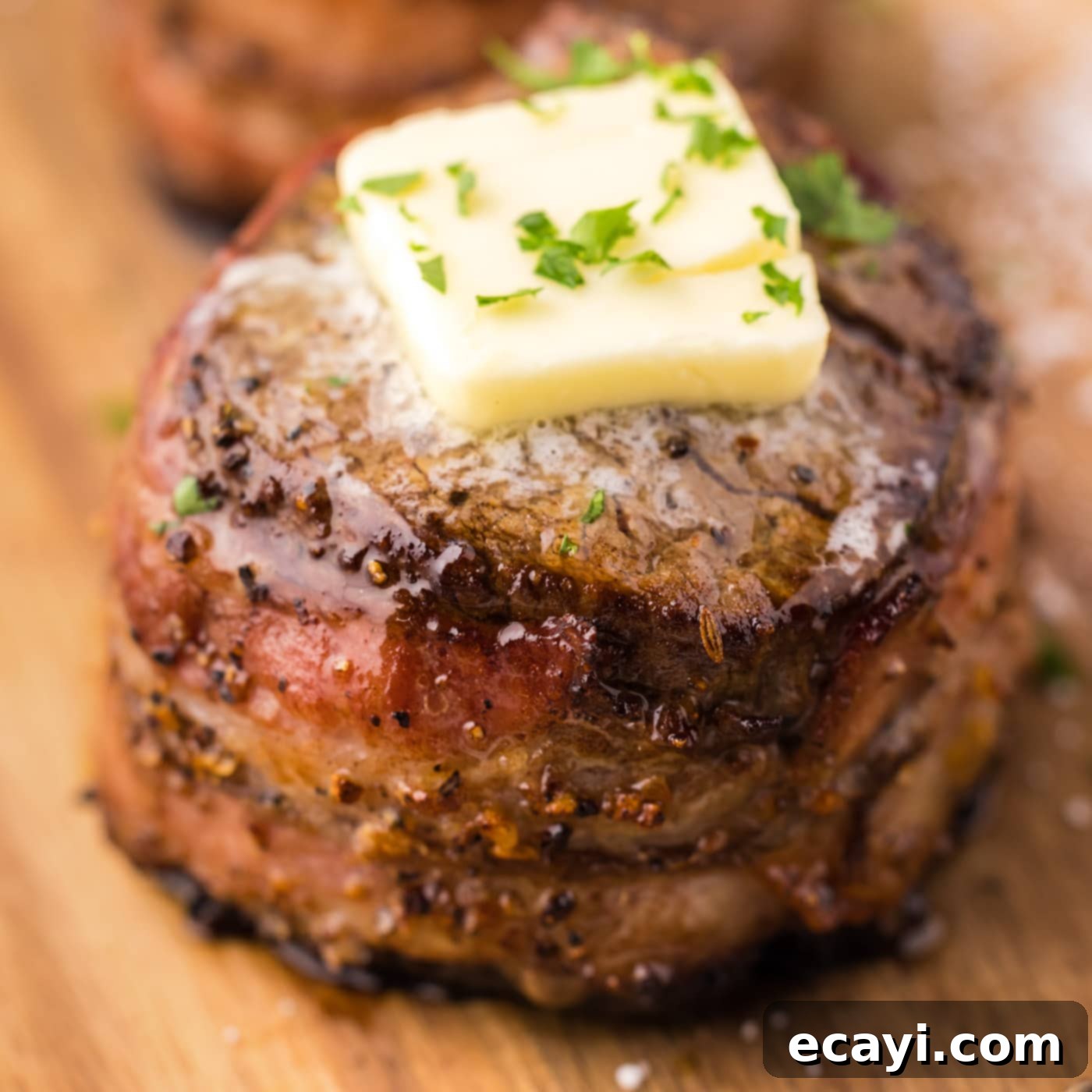Master the Perfect Bacon-Wrapped Filet Mignon: A Gourmet Steak Recipe in Under 20 Minutes
Prepare to impress with this incredible bacon-wrapped filet mignon recipe. Despite its sophisticated appearance, it’s remarkably simple to execute, bringing a touch of gourmet dining right to your kitchen. The secret lies in a dynamic cooking method: a quick, high-heat sear in a skillet followed by a short finish in the oven. This ensures a stunningly caramelized crust and a perfectly tender, juicy interior, all achieved in less than 20 minutes from start to finish. This recipe is designed for those who appreciate fine dining but prefer a straightforward approach, making it ideal for special occasions or an elevated weeknight meal.
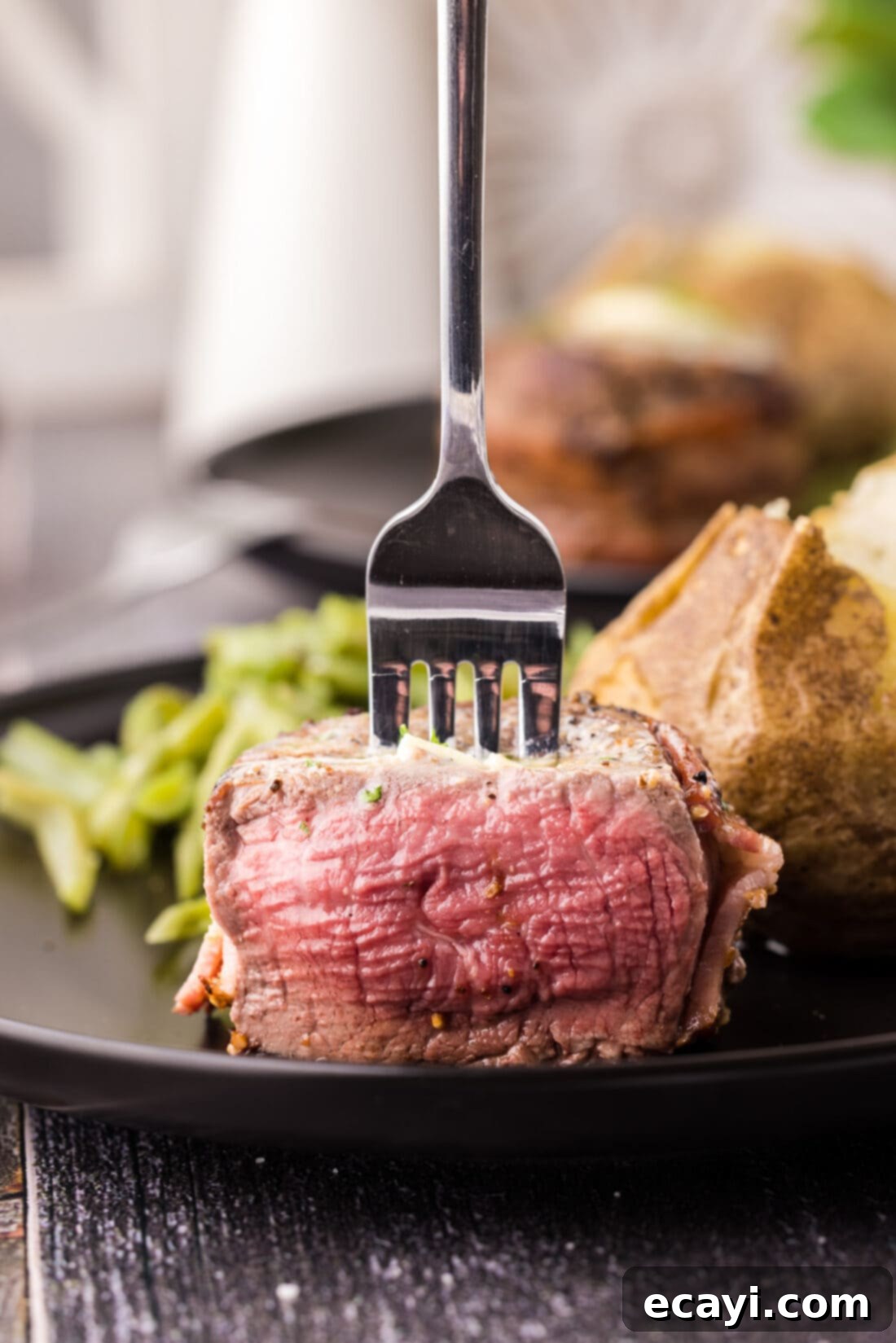
Why This Simple Method Guarantees a Perfect Filet
The brilliance of this recipe lies in its two-stage cooking technique: a searing hot skillet followed by a gentle finish in the oven. This method is the cornerstone for achieving a restaurant-quality steak every time, especially for a premium cut like filet mignon. When you first sear the filet in a scorching hot skillet, you initiate the Maillard reaction – a chemical process that creates that coveted savory, browned crust and locks in incredible flavor. This high heat, however, is too intense for sustained cooking without overdoing the exterior.
By transferring the steak to a preheated oven, you allow the heat to penetrate the filet more evenly and gently, bringing it to your desired doneness without scorching the outside. This controlled environment prevents the steak from drying out, resulting in a melt-in-your-mouth juicy texture, consistently cooked to a tender medium-rare. The bacon, wrapped snugly around the filet, plays a crucial role too. As it renders its fat, it bastes the delicate beef, adding a layer of rich, smoky flavor and preventing the lean filet from drying out. This synergistic approach simplifies what many perceive as a complicated process, delivering an incredible result with minimal fuss.
Looking to elevate your meal even further? If you have extra bacon on hand, consider adding bacon-wrapped scallops to your menu. They come together just as quickly and complement the filet mignon perfectly, creating a truly luxurious and elegant dining experience. It’s a testament to the power of bacon; honestly, it makes everything better, so put it to good use and transform an ordinary meal into something extraordinary!
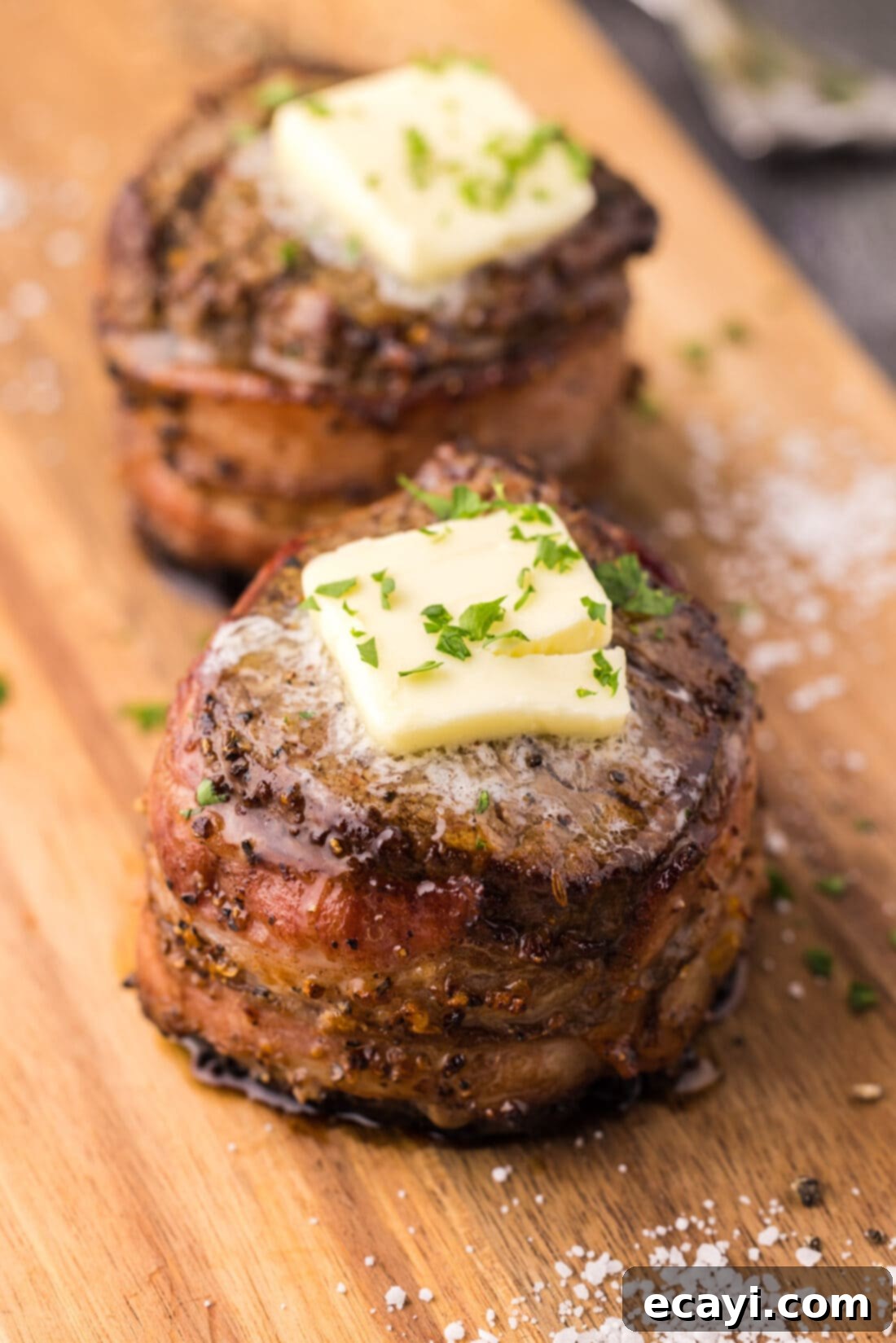
Essential Ingredients for Your Perfect Filet Mignon
Crafting a memorable bacon-wrapped filet mignon begins with selecting the right ingredients. While the list is short, the quality and type of each component make a significant difference in the final outcome. All specific measurements, ingredients, and detailed instructions can be found in the printable recipe card at the conclusion of this post.
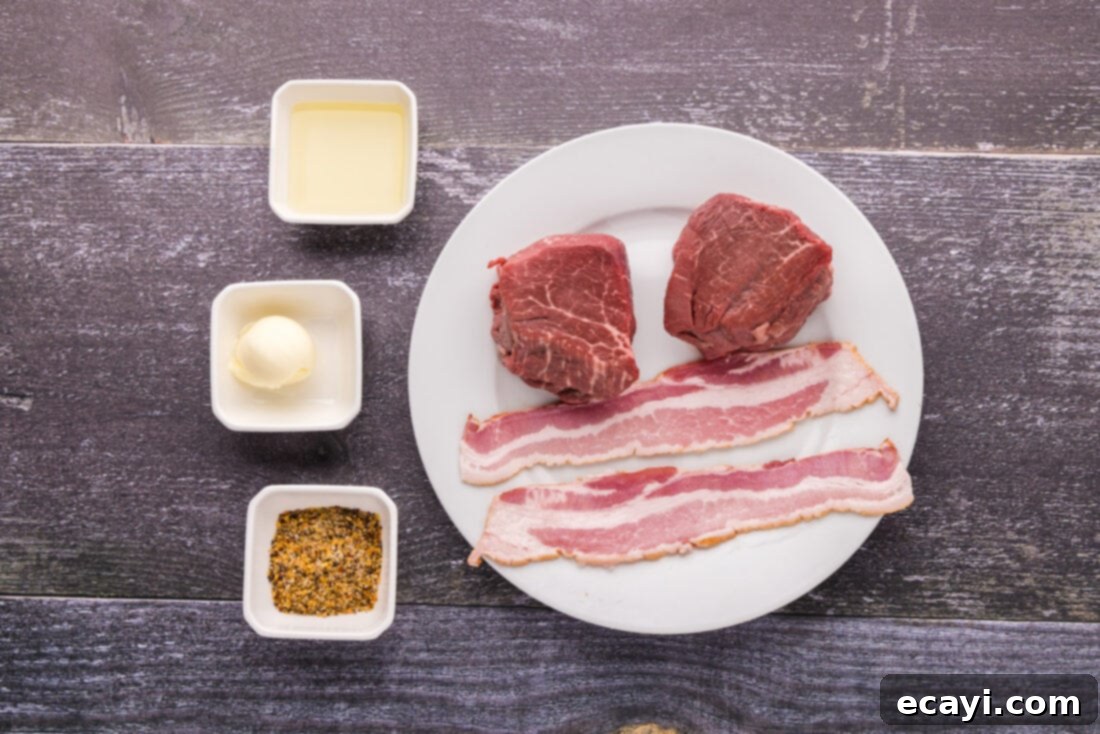
Ingredient Spotlight & Expert Tips for Selection
Understanding your ingredients is key to success. Here’s a closer look at what you’ll need and how to make the best choices:
- BACON: For this recipe, opt for regular-cut bacon. While thick-cut bacon might seem appealing for extra flavor, its extended cooking time can negatively impact the delicate doneness of your filet. Regular-cut bacon crisps up more quickly and evenly, ensuring it’s perfectly rendered and flavorful by the time your steak reaches medium-rare. Choose a good quality bacon, as its flavor will impart directly into your steak.
- FILETS: The star of the dish, filet mignon, is known for its incredible tenderness. Look for steaks that are at least 1.5 to 2 inches thick to allow for a proper sear without overcooking the center. It’s crucial to remove the steaks from the skillet promptly once seared and from the oven when they reach the target internal temperature. This is because meat continues to cook even after it’s removed from heat – a phenomenon known as carry-over cooking. For a perfect medium-rare, aim for an internal temperature of 130°F (54°C) when pulling them from the oven, as it will rise a few degrees as they rest. Always allow your steaks to rest for at least 5 minutes before slicing; this allows the juices to redistribute, ensuring a tender, moist, and flavorful bite.
- SEASONING: We recommend Chicago Steak seasoning for its robust blend of savory, peppery, and slightly garlicky notes, which perfectly complements the rich flavors of beef and bacon. Weber’s Chicago Steak Seasoning is a great choice. However, if you don’t have it on hand, a simple yet effective alternative is a generous application of coarse salt and freshly ground black pepper. You can also create your own blend using garlic powder, onion powder, paprika, and a touch of dried thyme for an equally delicious result.
- OLIVE OIL & BUTTER: Olive oil is essential for achieving a high-heat sear without burning. Choose a standard olive oil, as extra virgin olive oil has a lower smoke point and might burn at the temperatures needed for searing. Butter, added during the searing process, serves two purposes: it contributes a rich, nutty flavor and helps create a beautiful golden-brown crust. Brushing softened butter onto the filets before searing adds another layer of decadence and promotes even browning.
Mastering Bacon Wrapped Filet Mignon: A Step-by-Step Guide
These step-by-step photos and instructions are designed to help you visualize each stage of making this exquisite recipe. For a convenient printable version, complete with precise measurements and comprehensive instructions, simply Jump to Recipe at the bottom of this page.
- Preheat Oven: Begin by preheating your oven to a high temperature of 450°F (232°C). This high heat is crucial for ensuring the oven is ready to finish the steaks quickly and evenly after searing, providing a consistent cooking environment.
- Prepare Filets with Bacon: Take a slice of regular bacon and carefully wrap it around the circumference of each filet mignon. Ensure it’s snug but not overly tight. To secure the bacon firmly in place throughout the cooking process, use kitchen twine (butcher’s twine is ideal) or a couple of wooden toothpicks. This prevents the bacon from unraveling and ensures it crisps up nicely around the steak.
- Season Generously: Season all sides of the bacon-wrapped filets liberally with Chicago Steak seasoning. Ensure an even coating on every surface, including the bacon.
EXPERT TIP: For the best and most even coverage, pour your seasoning onto a small, flat plate. Then, gently roll each filet in the seasoning, pressing lightly to adhere the spices to the bacon and beef. This method ensures maximum flavor penetration and a beautiful crust. - Heat Skillet: Add 2 tablespoons of olive oil to a heavy-bottomed, oven-proof skillet (a cast-iron skillet is highly recommended for its excellent heat retention). Place the skillet over medium-high heat and allow the oil to heat until it just begins to shimmer and lightly smoke. A hot skillet is paramount for developing a perfect sear on your steaks.
- Prepare Butter: While the skillet heats, melt 1 tablespoon of butter until it reaches a soft, pudding-like consistency—it should be softened and spreadable, not fully liquid. Using a pastry brush, gently brush this softened butter over the top surface of both filets. This butter layer will enhance browning and flavor during the initial sear.
- Sear Filets: Carefully place the butter-brushed filets into the hot skillet, butter-side down. Allow them to sear undisturbed for 2-3 minutes until a beautiful, golden-brown crust forms. While the first side is searing, brush the exposed top side of each filet with the remaining softened butter. Then, using tongs, flip the steaks and sear on the opposite side for another 2-3 minutes. Continue to sear all remaining sides, including the bacon-wrapped edges, for about 1 minute per side, ensuring the bacon begins to crisp and render.
- Oven Finish: Once all sides are beautifully seared, transfer the entire skillet directly into your preheated 450°F (232°C) oven, leaving it uncovered. Roast for approximately 6-8 minutes for a perfect medium-rare doneness. For accurate results, use an instant-read meat thermometer inserted into the thickest part of the steak. Aim for an internal temperature of 130°F (54°C) for medium-rare.
- Rest and Serve: Carefully remove the skillet from the oven. Using tongs, immediately transfer the cooked steaks to a clean cutting board. Tent them loosely with aluminum foil to retain heat without steaming the crust, and allow them to rest for at least 5 minutes. This resting period is crucial as it allows the internal juices to redistribute throughout the steak, resulting in maximum tenderness and moisture. Remove the twine or toothpicks before serving.
Frequently Asked Questions & Expert Tips for Perfect Steak
Any leftover bacon-wrapped filet mignon should be stored in an airtight container and kept in the refrigerator. Properly stored, it will remain fresh and delicious for up to 4 days. When reheating, do so gently to avoid drying out the steak; a low oven or quick pan-sear is usually best.
Achieving the perfect doneness is critical for filet mignon. I suggest aiming for an internal temperature of 130°F (54°C) when you remove the filets from the oven for a beautiful medium-rare. Remember that the temperature will continue to rise by a few degrees as the steak rests (carry-over cooking). For medium doneness, cook until the internal temperature reaches 140°F (60°C). For rare, aim for 120°F (49°C). Always use an instant-read thermometer inserted into the thickest part of the steak to accurately gauge its temperature, avoiding the bone or bacon.
An oven-proof skillet is essential for this recipe’s sear-and-roast method. Cast iron skillets are highly recommended because they retain heat exceptionally well and distribute it evenly, leading to a superior sear and consistent cooking. Stainless steel skillets can also work if they are heavy-bottomed and oven-safe.
If your bacon isn’t as crispy as you’d like, ensure you’re using regular-cut bacon, not thick-cut. Also, ensure your skillet is very hot before adding the filets, as this helps render the fat quickly. Searing all sides of the bacon-wrapped filet, including the bacon-covered edges, will help it crisp up. If necessary, you can extend the searing time slightly on the bacon edges before transferring to the oven, but be careful not to overcook the steak.
Absolutely! While this recipe focuses on the skillet-to-oven method, bacon-wrapped filet mignon also cooks beautifully on the grill. The key is to sear it over direct high heat for 2-3 minutes per side to get those perfect grill marks and crispy bacon, then move it to indirect heat to finish cooking to your desired internal temperature. A meat thermometer is still your best friend here!
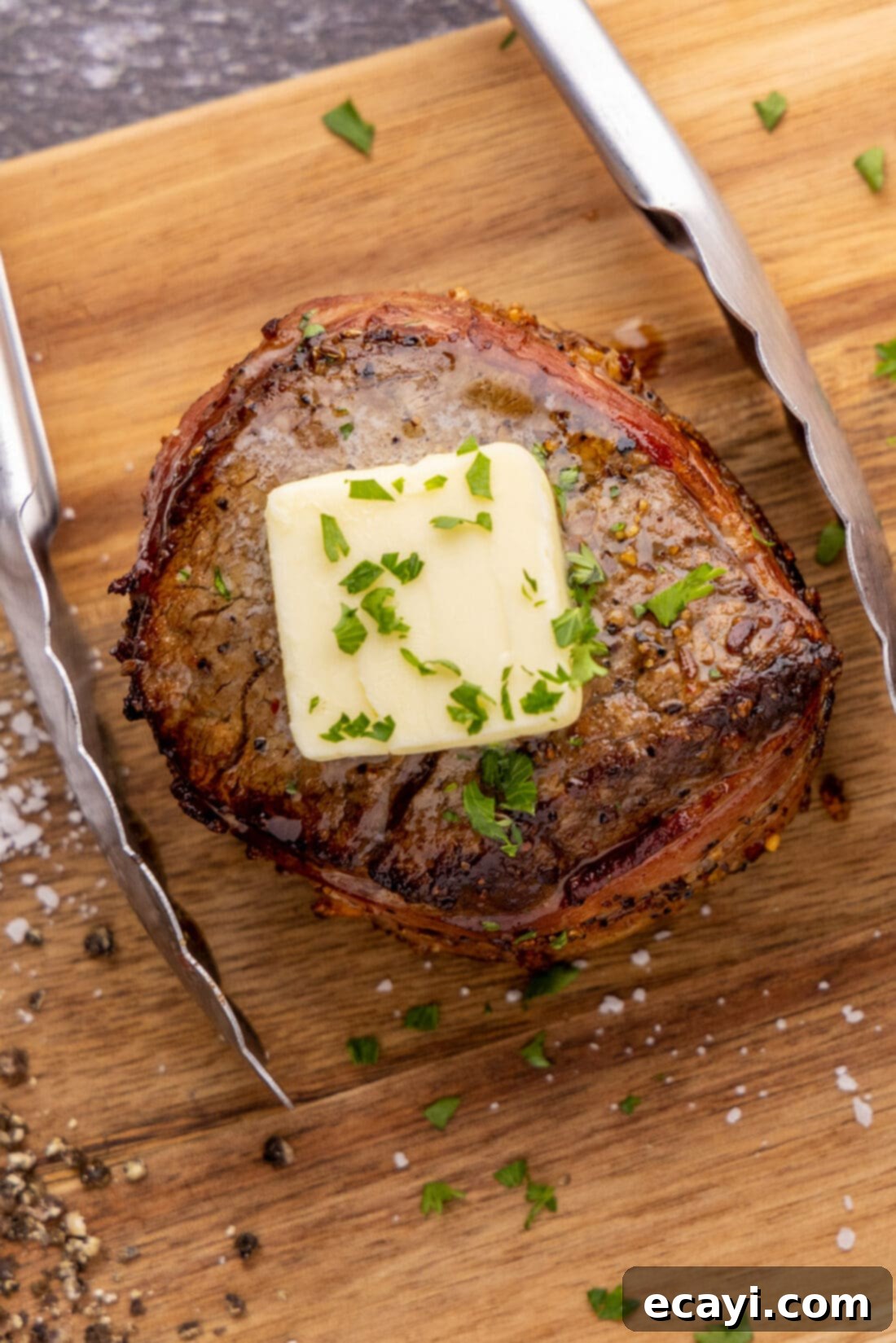
Elevate Your Meal: Delicious Serving Suggestions
Bacon-wrapped filet mignon is a showstopper on its own, but pairing it with the right side dishes can transform it into an unforgettable feast. Classic pairings include hearty potato dishes like cheesy bacon chive twice-baked potatoes, rich au gratin potatoes, or decadent loaded baked potatoes. The creamy, starchy potatoes provide a wonderful contrast to the tender steak and are perfect for soaking up any delicious juices. For a lighter, yet equally complementary option, consider a crisp wedge salad or a fresh leafy green dinner salad with a tangy vinaigrette. These offer a refreshing counterpoint to the richness of the steak and bacon. Other fantastic additions include roasted asparagus, creamed spinach, or mushrooms sautéed in garlic butter. Don’t forget a rich sauce, such as a red wine reduction, a classic béarnaise, or a simple dollop of compound butter, to add an extra layer of flavor complexity.
Discover More Incredible Steak Recipes
If you’ve mastered this bacon-wrapped filet mignon and are looking to expand your steak-cooking repertoire, here are some other fantastic recipes to try:
- Grilled Steak
- Steak Marinade
- Reverse Sear Ribeye
- Smoked Ribeye Steak
- Blue Cheese Crusted Steak
I love to bake and cook and share my kitchen experience with all of you! Remembering to come back each day can be tough, that’s why I offer a convenient newsletter every time a new recipe posts. Simply subscribe and start receiving your free daily recipes!

Bacon Wrapped Filet Mignon
IMPORTANT – There are often Frequently Asked Questions within the blog post that you may find helpful. Simply scroll back up to read them!
Print It
Pin It
Rate It
Save ItSaved!
Ingredients
- 1 pound filet mignons 2 filets, 1.5-2 inches thick for best results
- 2 slices bacon regular cut, not thick-cut
- 2 Tablespoons olive oil standard, for high-heat searing
- 1 Tablespoon butter softened
- 2 Tablespoons Chicago steak seasoning we used Weber brand, or preferred steak rub
Things You’ll Need
-
Oven proof skillet (cast iron recommended)
-
Instant-read thermometer
-
Kitchen twine or toothpicks
Before You Begin
- To achieve medium-rare steaks, remove them from the oven promptly when they reach an internal temperature of 130°F (54°C). The temperature will continue to rise during the resting period.
- Use an instant-read thermometer to accurately gauge doneness. For rare, target 120°F (49°C), and for medium, aim for 140°F (60°C).
- It is crucial to use regular-cut bacon for this recipe, as thick-cut bacon requires a longer cooking time that can easily overcook the delicate filet.
- Always allow your steaks to rest for at least 5 minutes after cooking. This crucial step allows the juices to redistribute throughout the meat, ensuring a more tender and flavorful result.
- Store any leftovers in an air-tight container in the refrigerator for up to 4 days.
Instructions
-
Preheat oven to 450 F (232°C).
-
Wrap a slice of regular-cut bacon around each filet mignon and secure it firmly with kitchen twine or toothpicks.
-
Season all sides of the bacon-wrapped filets generously with Chicago Steak seasoning.
TIP: For best coverage, put the seasoning on a small plate and roll the filets in it.
-
Add 2 tablespoons of olive oil to an oven-proof skillet (preferably cast iron) over medium-high heat. Heat until the oil is shimmering and just begins to smoke lightly.
-
Melt 1 tablespoon of butter until it has a soft, pudding-like texture. Brush this softened butter on the top of both filets.
-
Carefully add the filets to the hot oil, butter-side down, and sear for 2-3 minutes until a golden-brown crust forms. Brush the top side with butter as well, then flip and sear on the opposite side for another 2-3 minutes. Continue to sear all remaining sides (including bacon-covered edges) for about 1 minute per side until the bacon starts to crisp.
-
Place the skillet directly into the preheated oven, uncovered, for 6-8 minutes for medium-rare (target internal temperature of 130°F / 54°C). Adjust cooking time for desired doneness.
-
Remove the skillet from the oven and transfer the steaks to a cutting board. Tent lightly with foil and allow to rest for 5 minutes before serving. Remove twine/toothpicks before slicing.
Nutrition
The recipes on this blog are tested with a conventional gas oven and gas stovetop. It’s important to note that some ovens, especially as they age, can cook and bake inconsistently. Using an inexpensive oven thermometer can assure you that your oven is truly heating to the proper temperature. If you use a toaster oven or countertop oven, please keep in mind that they may not distribute heat the same as a conventional full sized oven and you may need to adjust your cooking/baking times. In the case of recipes made with a pressure cooker, air fryer, slow cooker, or other appliance, a link to the appliances we use is listed within each respective recipe. For baking recipes where measurements are given by weight, please note that results may not be the same if cups are used instead, and we can’t guarantee success with that method.
This post was originally published here on January 9, 2023, and has been updated with expanded content and expert tips.
